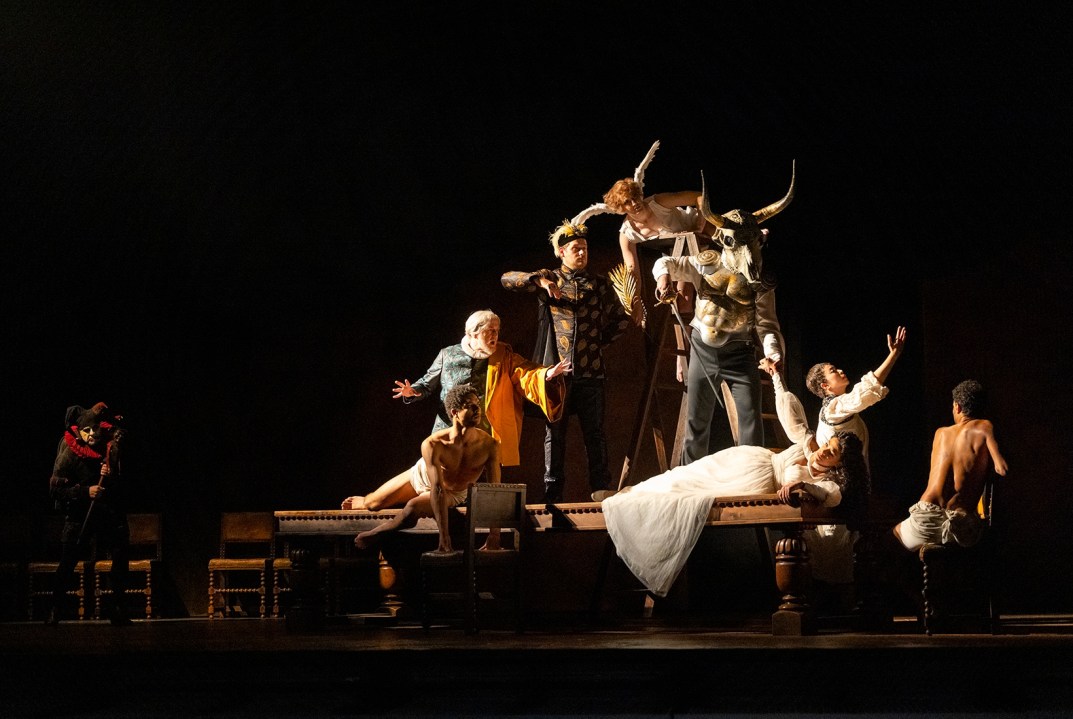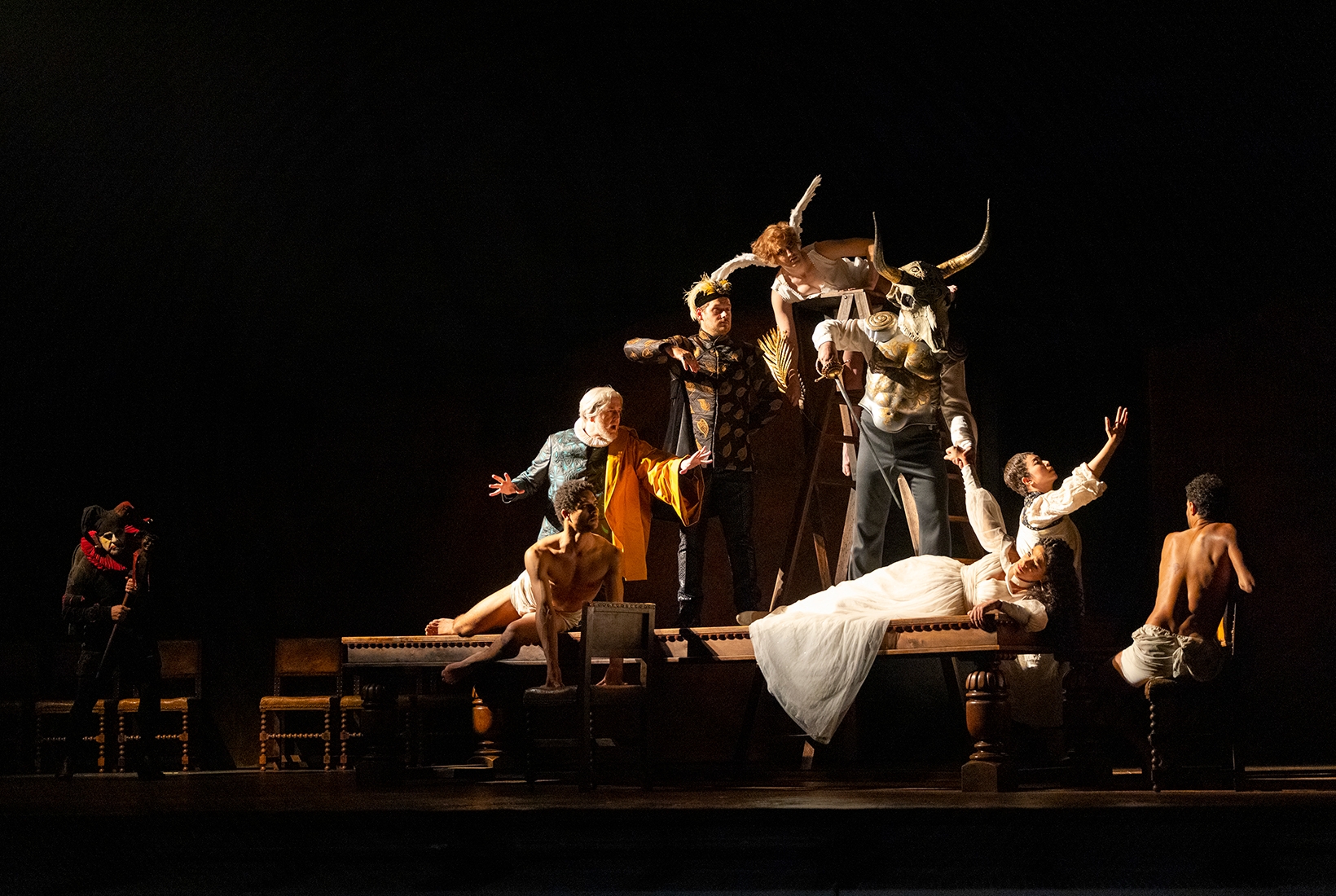In Oliver Mears’s new production of Verdi’s Rigoletto, the curtain rises on a work of art. The stage is in deep shadow, the backdrop glowing with the rich impasto of an old master painting. Out front, and lit like a Caravaggio, the Duke of Mantua poses amid a mass of human figures in sculptural attitudes. It’s a living representation of some allegorical Renaissance swagger portrait and, as we’re about to see, this Duke is something of a connoisseur. A colossal Venus of Urbino reclines lasciviously above the Act One orgy, replaced in Act Two by an equally gigantic Rubens: Europa riding a wild-eyed bull. Anyway, it looks classy and suitably historic. The offstage band chunters away, and the audience can breathe a sigh of relief.
It could have been very different. Every opera company needs to maintain a store cupboard of accessible, revivable productions: get it right (like Jonathan Miller’s 1980s-vintage Mikado and Rigoletto at ENO) and you’re looking at guaranteed box office decades into the future. Mears’s Rigoletto replaces a 20-year-old version by Sir David McVicar — last reheated in 2018 as a sort of upmarket post-Christmas show, presumably for families who feel that traditional panto doesn’t have enough sexual violence. But hey: nice costumes. This new staging — the first opera to be directed by Mears at Covent Garden since his appointment as director of opera in 2017 — represents something of a gamble. It’s never a good look when an artistic leader slaughters a cash cow.
How this Rigoletto will respond to an undercast mid-season revival 15 years from now, it’s unfair to speculate
So Mears hedges, but he hedges skilfully, and the result generates a potent atmosphere even beyond that opening tableau. The sets are semi-abstract; the costumes (by Ilona Karas) are multi-period generic but have obviously had some money spent on them, which always goes down well with this crowd. But there’s a river where there should be a river and a thunderstorm where there should be a thunderstorm, and you don’t have to be a swivel-eyed regie-phobe to feel that on balance this probably helps with the storytelling. Mears never lets the tension slip, marshalling the chorus so that their mere presence at the edge of the stage is enough to generate dread. This was a Rigoletto of mob violence and terrors lurking in the shadows, and Fabiana Piccioli’s lighting design deserves almost as much credit as Antonio Pappano’s conducting. That’s no backhanded compliment: Pappano’s sleek, purposeful interpretation, with its ominous bass surges and sudden streaks of blood and fire, was entirely gripping.
As to how this Rigoletto will respond to an undercast mid-season revival 15 years from now, it’s unfair to speculate, though I suspect it’ll look rather spartan. No question, though, Mears has fielded the A-team this time around, and the multilayered, charcoal-shaded nuances of Carlos Alvarez’s singing as Rigoletto were sufficient to offset his old-school crookback lurching — particularly when paired with Lisette Oropesa, whose Gilda was so poised and so luminous with emotion that she transfigured every scene in which she appeared. Liparit Avetisyan gave the Duke an easy charm that went beyond his elegant tenor and threw our sympathies dangerously in his favour, even after a moment of jarring, Grand Guignol savagery in Act One. Brindley Sherratt (Sparafucile) had a sinister dignity, and with his oily bass at the bottom, and Oropesa cutting through with almost unbearable sweetness at the top, the great Act Three quartet became a dramatic pivot point as well as a musical climax. See it while it’s still hot.
We’ll have to wait a long time before we get another chance to hear anything like Sir Simon Rattle’s latest jeu d’esprit with the London Symphony Orchestra — if you can apply that term to a composer as weighty, and as comprehensively traduced by his own fandom, as Anton Bruckner. Put simply (and as Rattle admitted in a twinkly podium chat, to go into much more detail risks sapping the will to live) Bruckner’s symphonies exist in a musicological hellscape of conflicting editions and alternative versions. It says something about the Bruckner cult that in 130-plus years of analysing and re-editing the various abandoned movements of the Fourth (‘Romantic’) Symphony that we heard tonight, no one apparently got around to organising a professional performance. You know — actually playing the stuff.
Rattle solved that in one bumper concert. Early versions of the symphony’s Scherzo and Finale felt like colossal holding patterns: epic musical structures in search of ideas to fill them. Then, after the interval, a complete performance of the finished symphony (in yet another new edition) added the missing thematic inspiration, and demonstrated that Bruckner’s revising instincts had been right all along. Who knew? Still, respect to Rattle for pursuing such a heroically nerdish enterprise, and to the brass section, in particular, for such a noble performance of a symphony that deserves to be loved more and dissected less.







Comments